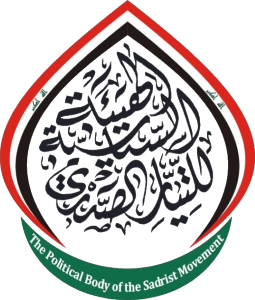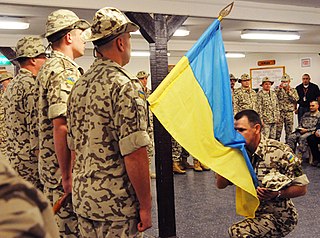
The Occupation of Iraq (2003–2011) was characterized by a large United States military deployment on Iraqi territory, beginning with the US-led invasion of the country in March 2003 which overthrew the Ba'ath Party government of Saddam Hussein and ending with the departure of US troops from the country in 2011. Troops for the occupation came primarily from the United States, the United Kingdom, and Australia, but 29 other nations also provided troops, and there were varying levels of assistance from Japan and other countries, as well as tens of thousands of private military company personnel.

Muqtada al-Sadr is an Iraqi Shia Muslim cleric, politician and militia leader. He inherited the leadership of the Sadrist Movement from his father. He founded the now dissolved Mahdi Army militia in 2003 that resisted the American occupation of Iraq. He also founded the Promised Day Brigade militia after the dissolution of Mahdi Army; both were backed by Iran. In 2014, he founded the Peace Companies militia and is its current head. In 2018, he joined his Sadrist political party to the Saairun alliance, which won the highest number of seats in the 2018 and 2021 Iraqi parliamentary elections.
Events in the year 2004 in Iraq.

The Mahdi Army was an Iraqi Shia militia created by Muqtada al-Sadr in June 2003 and disbanded in 2008.

After the 2003 invasion of Iraq was completed and the regime of Saddam Hussein was toppled in May 2003, an Iraqi insurgency began that would last until the United States left in 2011. The 2003–2006 phase of the Iraqi insurgency lasted until early 2006, when it escalated from an insurgency to a Sunni-Shia civil war, which became the most violent phase of the Iraq War.
Events in the year 2005 in Iraq.

The Mexican Army is the combined land and air branch and is the largest part of the Mexican Armed Forces; it is also known as the National Defense Army.

The Multi-National Force – Iraq (MNF–I), often referred to as the Coalition forces, was a military command during the 2003 invasion of Iraq and much of the ensuing Iraq War, led by the United States of America, United Kingdom, Australia, Italy, Spain and Poland, responsible for conducting and handling military operations.

The Sadrist Movement is an Iraqi Shi'a Islamic national movement and political party, led by Muqtada al-Sadr.

The Battle of Najaf was fought between United States and Iraqi forces on one side and the Mahdi Army led by Muqtada al-Sadr on the other in the Iraqi city of Najaf in August 2004.

The 2004 Iraq spring fighting was a series of operational offensives and various major engagements during the Iraq War. It was a turning point in the war; the Spring Fighting marked the entrance into the conflict of militias and religiously based militant Iraqi groups, such as the Shi'a Mahdi Army.
Operation Black Eagle is an operation that took place during Operation Iraqi Freedom from 2003 to 2010. It was the 381st listed operation during the Iraq war in 2003 Black Eagle was an operation in which U.S. Polish, and Iraqi troops battled gunmen loyal to anti-American cleric Muqtada al-Sadr in the town of Al Diwaniyah, which is the capital of Iraq's Al-Qādisiyyah Governorate, for control of the city. U.S. warplanes targeted insurgent positions with Hellfire missiles in and near the city. As of 7 April 2007, Iraqi officials have verified six insurgents killed and 39 captured. On 10 April 2007, combat operations had been declared to have ended and the operation continued into the reconstruction phase. There is no relation to Operation Black Eagle II that took place in January 2007.

Florencio Xatruch was a general who led the Honduran expeditionary force against William Walker in Nicaragua in 1856.

The Salvadoran Army is the land branch and largest of the Armed Forces of El Salvador.

Operation Phantom Strike was a major offensive launched by the Multi-National Corps – Iraq on 15 August 2007 in a crackdown to disrupt both the al-Qaeda-affiliated Islamic State of Iraq and Shia insurgent operations in Iraq. It consisted of a number of simultaneous operations throughout Iraq focused on pursuing remaining ISI terrorists and Iranian-supported insurgent groups. It was concluded in January 2008 and followed up with Operation Phantom Phoenix.

Multinational Division Central-South (MND-CS), created in September 2003, and supported by NATO, was a part of the Multinational Force Iraq. Headquartered in Camp Echo, it was under Polish command until October 2008, when the last of Poland's troops were withdrawn. The Polish contingent was its largest. Other participants included Armenia, Bosnia and Herzegovina, Bulgaria, Denmark, Kazakhstan, Latvia, Lithuania, Mongolia, Norway, Romania, El Salvador, Slovakia, Spain, Ukraine and the United States of America. As of December 2008, Armenian, Bosnian, Danish, Latvian, Kazakh, Lithuanian, Mongolian, Spanish and Slovakian forces had been fully withdrawn.
Alberto Teófilo Asarta Cuevas is a Spanish military officer and politician. He was promoted to Major General in July 2009, and he has participated in United Nations peacekeeping missions in El Salvador, Bosnia-Herzegovina and Lebanon and in the multi-national force deployed in the Iraq War. He has served as Force Commander of UNIFIL from January 28, 2010. until January 28, 2012.
The Battle of Sabzak was an engagement between Spanish and Italian forces of NATO's International Security Assistance Force (ISAF) and Taliban insurgents supported by militant Tajik tribals. The action took place from 3 to 4 September 2009 on Sabzak pass, in the province of Badghis, during the War in Afghanistan.

Ukraine began its involvement in the Iraq War on 5 June 2003, shortly after the 2003 invasion of Iraq. Throughout the conflict, Ukrainian troops were limited to a peacekeeping role, as part of the Multi-National Force – Iraq, though they engaged in combat with Iraqi insurgents. On 9 December 2008, Ukraine formally withdrew its last forces from Iraq, ending its participation in the Iraq War. Prior to the Russo-Ukrainian War, Ukraine's involvement in the Iraq War was the largest military operation ever performed by the Armed Forces of Ukraine. Over 6,000 Ukrainians performed military service in Iraq and Kuwait during the war, including a permanent presence of 1,600, and 18 Ukrainians were killed.













